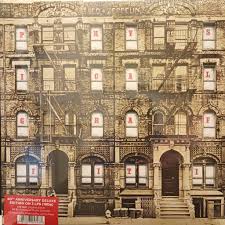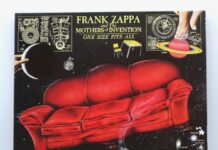Double albums, especially those released in the 1970s, are tricky beasts for a modern music lover; often, they are overloaded with stuff targeted exclusively at the most diehard segment of the band’s fanbase. Even with the rose-colored glasses on, these endeavors have a habit of being but meandering attempts at imbuing the excesses of progressive rock, regardless of whether the band fits the label. LED ZEPPELIN‘s 1975 double treat “Physical Graffiti” makes no exception to this rule. Released on February 24th in the United States and on 28th in the United Kingdom, their sixth studio album marked the first release on their new label Swan Song Records. As far as I know, dubious stimulants or psychedelic concoctions played no part in the making of this album but, still, the band was pretty close to teetering on the verge of collapse. Tired from touring and somewhat disillusioned with the group, John Paul Jones almost quit the band during the first sessions at the Headley Grange mansion in Hampshire, England, where LED ZEPPELIN had recorded their timeless magnum opus “Led Zeppelin IV.” However, these sessions produced the embryonic, first stages of the absolute classic-to-be, “Kashmir,” without which the album might have suffered the fate of getting buried in history. The material from these sessions comprised just under three sides of an LP, overall, and, instead of making executive decisions, the band opted for releasing a double album by including all sorts of unreleased tracks from previous sessions. This minor faux pas ensured that the contrast between the peaks and the valleys on this album was quite remarkable.
There were other factors to take into account, as well, as to why the band was not as up to bar as the straight-up superb album run thus far might have suggested. First, vocalist Robert Plant was recovering from a vocal cord surgery. It is not so obvious on the outing, but his signature falsetto screeching is largely absent and, hence, you won’t be hearing “Whoa!,” “Mama!,” or “Baby!” so often in the lyrics. These “Plantisms” are almost entirely reserved for the acoustic song, “Black Country Woman,” in which you can count twelve mamas and four babies. Maybe the band thought it would suffice to squeeze them all into a single song and make it a bit more mellow. John Bonham‘s groovy beats save the song from being a complete mess.
That said, Plant gets pretty liberal with the use of the word, “Mama,” in the country-rock romper-stomper entitled “Night Flight,” too. Bonham‘s drumming is “in the pocket,” as the saying goes but, otherwise, the song just doesn’t seem to get the momentum going; it is almost as if the band were playing on autopilot. Page plays the guitar through a Leslie speaker but the song is a far cry from the lysergic greatness of later “Leslie-guitar classics,” such as “Black Hole Sun” by SOUNDGARDEN.
The only song in which you can easily spot subtle problems in Plant‘s voice when you put your ear to it, is the hard-rock riffer, “The Rover,” which dates back to 1970. The song was a leftover from the “Led Zeppelin III” sessions, later reworked for the 1973 album, “Houses of the Holy,” but not included in it. Well, it’s not the worst song in the band’s catalog but I think it was left out from the previous endeavors for a reason.
What remained virtually intact on this album and what had been an ongoing streak since the early days of the band was the prominent use of sexual innuendos and double entendres in the lyrics. Then again, LED ZEPPELIN was notorious for lifting riffs and lyrics from pedigree blues masters, so I guess the excessive use of euphemisms came from there. It is all over the place right off the bat, in the opening song, “Custard Pie,” the lyrics of which hardly manage to veil the references to oral sex; it is almost as though the lyrics are intended as a not-so-subtle nudge and wink at the predominantly adolescent male fanbase. Okay, well… it was the silly 1970s remember? Musically, the song is not so silly. Jones drops some biting clavinet riffs and Jimmy Page‘s guitar solo, played through the legendary ARP synthesizer, still sounds pretty rad.
Any way I look at it, however, the decision to release a four-sided double album with decent material for only two sides seems a bit ill-advised. For example, tracks such as “Boogie with Stu,” “Ten Years Gone,” and “Down by the Seaside” feel more like nothingburners than portfolio pieces. On the upside, this overblown double feature not only gave us “Kashmir” but also classics such as “Trampled Under Foot” and the progressive beast, “In the Light.” The leftover track from the 1972 sessions for the album of the same name, “Houses of the Holy,” is often regarded as one of LED ZEPPELIN’s classics, too. Of these, “Kashmir” is THE song that has stood the test of time most valiantly; a sonic souvenir from the band’s visit to Morocco, the song blends Middle-Eastern vibes with their trademark sound so beautifully that it became an instant staple in the band’s live shows from 1975 onward. The song is structured around two distinct hooks; first, you simply cannot resist the lure of the Middle-Eastern strings layered with Mellotron, and, second, half the magic comes from Bonham‘s iconic drumming. Instead of following the triplet-meter guitar riffs, he plays a contrasting rhythm, emphasizing the backbeat. The song is all about tension and release. (The live version from Knebworth, 1979, is pretty damn good!)
Lastly, while some of the acoustic numbers on this album leave quite a lot to hope for, another leftover from the “Led Zeppelin III” sessions, “Bron-Yr-Aur” is a nice attempt to impersonate the sound of COSBY, STILLS, NASH & YOUNG. Judging by the title, it must be sort of like the little brother to the acoustic song that made it to that “Led Zeppelin III” album – “Bron-Yr-Aur Stomp.” Both songs were named after the cottage where Page and Plant had composed and arranged much of that third album. The one saved for “Physical Graffiti” is a somewhat softer take on the matter.
In conclusion, five tracks out of the fifteen turned out to be real bangers in this selection. So, I guess this confirms the urban myth that double albums are typically comprised so that one-third is really good, one-third is merely okay, and one-third is more or less rubbish. In this case, the really good part just happens to be so damn good that it advocates purchasing this LED ZEPPELIN offering, if only for the progressive, almost forgotten gem, “In the Light,” because it isn’t typically included in the band’s “Greatest Hits” compilations whatsoever. Yeah, the song IS that good. Revisiting this album after something like 20 years, I almost mistook the song’s droning intro for a VON HERTZEN BROTHERS piece – until Plant‘s vocal kicked in. At their best, LED ZEPPELIN sure knew how to sound timeless and while this double treat is far from their most coherent albums, it does come with a few of their best songs.
Written by Jani Lehtinen
Tracklist
Side A:
- Custard Pie
- The Rover
- In My Time of Dying
Side B:
- Houses of the Holy
- Trampled Under Foot
- Kashmir
Side C:
- In the Light
- Bron-Yr-Aur
- Down by the Seaside
- Ten Years Gone
Side D:
- Night Flight
- The Wanton Song
- Boogie with Stu
- Black Country Woman
- Sick Again
Lineup
Robert Plant – vocals, harmonica
Jimmy Page – guitars, production
John Paul Jones – bass, mandolin, acoustic guitar, keyboards
John Bonham – drums, percussion
Label
Swan Song Records






